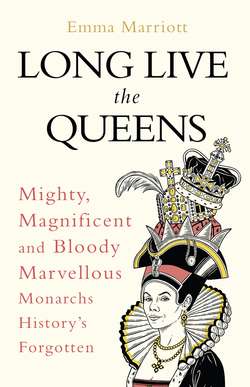Читать книгу Long Live the Queens: Mighty, Magnificent and Bloody Marvellous Monarchs History’s Forgotten - Emma Marriott - Страница 6
Introduction
ОглавлениеThroughout history, queens have wielded significant power and influence, and yet surprisingly few have received the kind of attention or fame they deserve. This book shines a light on these lesser-known sovereigns, many of whom proved themselves as shrewd politicians, able administrators or mighty commanders of armies, whilst others were as flawed or as brutal as their male counterparts.
Here are queens who have been long forgotten, overlooked, unfairly maligned or simply dismissed as mere bit-players on the world stage. Some ruled as queens in their own right whilst others were crowned queen consorts to kings. Many ruled on behalf of young heirs, fiercely protecting their offspring’s right to succeed, whilst others took over the reins of power when their kings were away for months, if not years. And some queens were forced to usurp power from inept husbands, when it was clear they had strength of character and were far better equipped to rule.
Not that ruling as Queen was all that easy: top of the tick-list of requirements for many queens was to produce the all-important heir to the throne (and preferably a couple of spares). Queens were also expected to be the model of subservience and virtue, no matter how badly their husbands behaved, whilst also acting as the ‘human face’ of the crown, giving alms to the poor, patronising religious institutions, smoothing over family and dynastic disputes and sponsoring artistic and literary endeavours.
Fulfilling all the expectations for a queen was indeed a tricky balancing act, for which they have always been harshly judged. Toe the line, produce a batch of sons, behave modestly and smile nicely at court and history may well forget you. Fail to produce an heir and you might be replaced or despatched (the nasty way). Refuse to submit to your husband or rail against his infidelities and you’ll be judged wilful or even mad. And should you wield power and maybe punish your rivals as men have done for centuries, then chances are you’ll be labelled as an evil tyrant/monster (but, then again, at least you might not be entirely forgotten …)
The queens covered in this book may have been cast into the shadows in some way, but they all have extraordinary stories to tell. Some, like Boudica, were once entirely forgotten, only to surface centuries later. Many queens are famous in their homelands but decidedly not famous elsewhere in the world; some names might trigger a twitch of recognition but many would draw a blank. There have also been deliberate attempts in the past to wipe some queens from memory, almost as if they were seen as an embarrassment, an anomaly best forgotten in the male-to-male succession. (Thankfully, archaeologists have unearthed the truth about the likes of ancient Egypt’s Hatshepsut, but are there other queens we know nothing about?) There are also those queens who have been defined largely by the exploits of their husbands (Catherine of Aragon and Katherine Parr step forward) or have made handy ‘withered hags’ in works of fiction (cue Margaret of Anjou) but whose portrayals bear little reality to their actual lives.
Forgotten, glossed over or much maligned, the queens in this book lived from as long as ago as 1500 BCE right up to the early twentieth century, and cover the globe from Europe to Africa, the Americas and the Middle East. They are grouped into seven chapters, loosely defined by their style of rule or deeds. The queens represented as trailblazers mark some of the sovereigns who were the first of a kind, whose reigns marked a zenith of a particular empire or set in motion a later momentous event. History is awash with free-thinking queens, those who were led by their own convictions and ideas regardless of what was expected of them. The warrior queens are an impressive group, although history tends to treat them with either awe or disgust, a surprising number of them supposedly having voracious sexual appetites or bumping off their lovers before the bedsheets were even cold.
Some female rulers, deemed ‘rebels’ in this book, fought against mighty and rapacious empires, controlling husbands or the restrictions placed on them as queens. Other rulers did well to survive, as being a queen is not necessarily an easy ride. Girls from noble families, bred to be dynastic pawns, were sent off to strange lands at ridiculously young ages, often to marry much older men before suffering pregnancy after pregnancy, the death of infants, perilous court factions, and a less-than-welcoming attitude by many men to women having so much as an ounce of power. To survive all of that and then actually achieve something – well, that definitely is worth remembering. A sixth sense seems almost to have told some queens that they needed to make their mark, stamping their authority as image-makers on coins, on statues and in monumental structures that some male successors even attempted to pass off as their own. The guiding lights of this world are queens who provided wise counsel to their husbands or subjects, or who defined the role of queenship for others to follow in their stead.
They’re all here – fearsome elephant-riding warrior queens, ruthless trailblazers, cross-dressing rebels, lusty free-thinkers, tough-as-boots survivors and enlightened guiding lights. It’s time to find out just how mighty, magnificent and bloody marvellous these forgotten queens really were.
